Water Flow Boiling in Micro/Mini Channels Using Volume of Fluid Model
Abstract
:1. Introduction
2. Numerical Solution
2.1. Governing Equations
2.2. Computational Model
2.3. Mesh Independence Study
3. Results and Discussion
4. Conclusions
- At a low mass flux of 11.09 kg/(m2.s), the VOF model over-predicts HTC in the NB regime and predicts linear variation of HTC. This could be attributed to the Lee phase change model, which depends on the linear deviation of bulk temperature from saturation temperature.
- At moderate mass fluxes, the model shows a decrease in over-prediction, and a slight under-prediction of HTC is seen in convection boiling regimes.
- The model best predicts HTC at high mass fluxes, wherein numerical results exactly follow experimental results. The maximum error also comes down to +7%.
Author Contributions
Funding
Informed Consent Statement
Data Availability Statement
Conflicts of Interest
References
- Silvi, L.D.; Chandraker, D.K.; Ghosh, S.; Das, A.K. Understanding Dry-out Mechanism in Rod Bundles of Boiling Water Reactor. Int. J. Heat Mass Transf. 2021, 177, 121534. [Google Scholar] [CrossRef]
- Konishi, C.; Mudawar, I. Review of Flow Boiling and Critical Heat Flux in Microgravity. Int. J. Heat Mass Transf. 2015, 80, 469–493. [Google Scholar] [CrossRef]
- Wang, J.X.; Guo, W.; Xiong, K.; Wang, S.N. Review of Aerospace-Oriented Spray Cooling Technology. Prog. Aerosp. Sci. 2020, 116, 100635. [Google Scholar] [CrossRef]
- Leong, K.C.; Ho, J.Y.; Wong, K.K. A Critical Review of Pool and Flow Boiling Heat Transfer of Dielectric Fluids on Enhanced Surfaces. Appl. Therm. Eng. 2017, 112, 999–1019. [Google Scholar] [CrossRef]
- Liu, X.; Su, G.; Yao, Z.; Yan, Z.; Yu, Y. Numerical Study of Flow Boiling of ADN-Based Liquid Propellant in a Capillary. Materials 2023, 16, 1858. [Google Scholar] [CrossRef] [PubMed]
- Wang, J.; Wang, B.; Xie, J.; Lei, K.; Yu, B.; Sun, Y. Numerical Simulation Research of Bubble Characteristics and Bubble Departure Diameter in Subcooled Flow Boiling. Mathematics 2022, 10, 4103. [Google Scholar] [CrossRef]
- Hu, C.; Wang, R.; Yang, P.; Ling, W.; Zeng, M.; Qian, J.; Wang, Q. Numerical Investigation on Two-Phase Flow Heat Transfer Performance and Instability with Discrete Heat Sources in Parallel Channels. Energies 2021, 14, 4408. [Google Scholar] [CrossRef]
- Fsadni, A.M.; Whitty, J.P.M. A Review on the Two-Phase Heat Transfer Characteristics in Helically Coiled Tube Heat Exchangers. Int. J. Heat Mass Transf. 2016, 95, 551–565. [Google Scholar] [CrossRef]
- Owhadi, A.; Bell, K.J.; Crain, B. Forced Convection Boiling inside Helically-Coiled Tubes. Int. J. Heat Mass Transf. 1968, 11, 1779–1793. [Google Scholar] [CrossRef]
- Chen, J.C. Correlation for Boiling Heat Transfer to Saturated Fluids in Convective Flow. Ind. Eng. Chem. Process Des. Dev. 1966, 5, 322–329. [Google Scholar] [CrossRef]
- Steiner, D.; Taborek, J. Flow Boiling Heat Transfer in Vertical Tubes Correlated by an Asymptotic Model. Heat Transf. Eng. 1992, 13, 43–69. [Google Scholar] [CrossRef]
- Niu, X.; Yuan, H.; Zhao, L. Experimental Study on Critical Heat Flux during Flow Boiling of R134a in a Vertical Helically Coiled Tube. Proc. Inst. Mech. Eng. Part C J. Mech. Eng. Sci. 2020, 234, 3094–3101. [Google Scholar] [CrossRef]
- Tanaka, K. NII-Electronic Library Service. Chem. Pharm. Bull. 1977, 57, 364–370. [Google Scholar]
- Guo, L., Chen. Forced Convection Boiling Heat Transfer and Dryout Characteristics in Helical Coiled Tubes with Various Axial Angles. In Proceedings of the 11th Conference IHTC, Kyongju, Republic of Korea, 23–28 August 1988; Volume 2, pp. 261–266. [Google Scholar]
- Zhao, L.; Guo, L.; Bai, B.; Hou, Y.; Zhang, X. Convective Boiling Heat Transfer and Two-Phase Flow Characteristics inside a Small Horizontal Helically Coiled Tubing Once-through Steam Generator. Int. J. Heat Mass Transf. 2003, 46, 4779–4788. [Google Scholar] [CrossRef]
- Yi, J.; Liu, Z.-H.; Wang, J. Heat Transfer Characteristics of the Evaporator Section Using Helical Coiled Pipes in a Looped Heat Pipe. Appl. Therm. Eng. 2003, 23, 89–99. [Google Scholar] [CrossRef]
- Chen, S.W.; Hsieh, J.C.; Chou, C.T.; Lin, H.H.; Shen, S.C.; Tsai, M.J. Experimental Investigation and Visualization on Capillary and Boiling Limits of Microgrooves Made by Different Processes. Sens. Actuat. 2007, A139, 78–87. [Google Scholar] [CrossRef]
- Hendricks, T.J.; Krishnan, S.; Choi, C.; Chang, C.H.; Paul, B. Enhancement of Pool Boiling Heat Transfer Using Nanostructured Surfaces on Aluminum and Copper. ASME Int. Mech. Eng. Congr. Expo. Proc. 2010, 12, 1025–1033. [Google Scholar] [CrossRef]
- Kim, S.; Kim, H.D.; Kim, H.; Ahn, H.S.; Jo, H.; Kim, J.; Kim, M.H. Effects of Nano-Fluid and Surfaces with Nano Structure on the Increase of CHF. Exp. Therm. Fuild Sci. 2010, 34, 487–495. [Google Scholar] [CrossRef]
- Ahn, H.S.; Park, G.; Kim, J.M.; Kim, J.; Kim, M.H. The Effect of Water Absorption on Critical Heat Flux Enhancement during Pool Boiling. Exp. Therm. Fluid Sci. 2012, 42, 187–195. [Google Scholar] [CrossRef]
- Etminan, A.; Muzychka, Y.S.; Pope, K. A Review on the Hydrodynamics of Taylor Flow in Microchannels: Experimental and Computational Studies. Processes 2021, 9, 870. [Google Scholar] [CrossRef]
- Mukherjee, A.; Kandlikar, S.G. Numerical Simulation of Growth of a Vapor Bubble during Flow Boiling of Water in a Microchannel. Microfluid. Nanofluidics 2005, 1, 137–145. [Google Scholar] [CrossRef]
- Mukherjee, A.; Kandlikar, S.G. The Effect of Inlet Constriction on Bubble Growth during Flow Boiling in Microchannels. Int. J. Heat Mass Transf. 2009, 52, 5204–5212. [Google Scholar] [CrossRef]
- Lee, W.; Son, G. Bubble Dynamics and Heat Transfer during Nucleate Boiling in a Microchannel. Numer. Heat Transf. Part Appl. 2008, 53, 1074–1090. [Google Scholar] [CrossRef]
- Ewe, W.E.; Fudholi, A.; Sopian, K.; Solomin, E.; Yazdi, M.H.; Asim, N.; Fatima, N.; Pikra, G.; Sudibyo, H.; Fatriasari, W.; et al. Jet Impingement Cooling Applications in Solar Energy Technologies: Systematic Literature Review. Therm. Sci. Eng. Prog. 2022, 34, 101445. [Google Scholar] [CrossRef]
- Etminan, A.; Harun, Z. Forced Convective Heat Transfer Analysis for Two-Dimensional Slot Jet of Water-CuO Nanofluid. J. Kejuruter. 2021, 33, 229–238. [Google Scholar] [CrossRef] [PubMed]
- Hasan, H.; Alquziweeni, Z.; Sopian, K. Heat Transfer Enhancement Using Nanofluids for Cooling a Central Processing Unit (CPU) System. J. Adv. Res. Fluid Mech. Therm. Sci. 2018, 51, 145–157. [Google Scholar]
- Faris Abdullah, M.; Zulkifli, R.; Harun, Z.; Abdullah, S.; Wan Ghopa, W.A.; Soheil Najm, A.; Humam Sulaiman, N. Impact of the TiO2 Nanosolution Concentration on Heat Transfer Enhancement of the Twin Impingement Jet of a Heated Aluminum Plate. Micromachines 2019, 10, 176. [Google Scholar] [CrossRef]
- Zu, Y.Q.; Yan, Y.Y.; Gedupudi, S.; Karayiannis, T.G.; Kenning, D.B.R. Confined Bubble Growth during Flow Boiling in a Mini-/Micro-Channel of Rectangular Cross-Section Part II: Approximate 3-D Numerical Simulation. Int. J. Therm. Sci. 2011, 50, 267–273. [Google Scholar] [CrossRef]
- Garoosi, F.; Hooman, K. Numerical Simulation of Multiphase Flows Using an Enhanced Volume-of-Fluid (VOF) Method. Int. J. Mech. Sci. 2022, 215, 106956. [Google Scholar] [CrossRef]
- Zhuan, R.; Wang, W. Simulation on Nucleate Boiling in Micro-Channel. Int. J. Heat Mass Transf. 2010, 53, 502–512. [Google Scholar] [CrossRef]
- Mulbah, C.; Kang, C.; Mao, N.; Zhang, W.; Shaikh, A.R.; Teng, S. A Review of VOF Methods for Simulating Bubble Dynamics. Prog. Nucl. Energy 2022, 154, 104478. [Google Scholar] [CrossRef]
- Zhao, S.; Zhang, J.; Ni, M.-J. Boiling and Evaporation Model for Liquid-Gas Flows: A Sharp and Conservative Method Based on the Geometrical VOF Approach. J. Comput. Phys. 2022, 452, 110908. [Google Scholar] [CrossRef]
- Zhang, J.; An, J.; Lei, L.; Wang, X.; Xin, G.; Wu, Z. Numerical Investigation of Heat Transfer and Pressure Drop Characteristics of Flow Boiling in Manifold Microchannels with a Simple Multiphase Model. Int. J. Heat Mass Transf. 2023, 211, 124197. [Google Scholar] [CrossRef]
- Vaishnavi, G.N.V.S.; Ramarajan, J.; Jayavel, S. Numerical Studies of Bubble Formation Dynamics in Gas-Liquid Interaction Using Volume of Fluid (VOF) Method. Therm. Sci. Eng. Prog. 2023, 39, 101718. [Google Scholar] [CrossRef]
- Lin, C.-W.; Lin, Y.-C.; Kumar, R.; Lin, M.-C.; Hsu, H.-Y. A Numerical Study of Microtube Geometry Effect on Flow Boiling Using the Volume of Fluid Method. Int. J. Heat Mass Transf. 2022, 199, 123477. [Google Scholar] [CrossRef]
- Bureš, L.; Sato, Y. Direct Numerical Simulation of Evaporation and Condensation with the Geometric VOF Method and a Sharp-Interface Phase-Change Model. Int. J. Heat Mass Transf. 2021, 173, 121233. [Google Scholar] [CrossRef]
- Shang, X.; Zhang, X.; Nguyen, T.-B.; Tran, T. Direct Numerical Simulation of Evaporating Droplets Based on a Sharp-Interface Algebraic VOF Approach. Int. J. Heat Mass Transf. 2022, 184, 122282. [Google Scholar] [CrossRef]
- Etminan, A.; Muzychka, Y.S.; Pope, K. CFD Modelling for Gas-Liquid and Liquid-Liquid Taylor Flows in the Entrance Region of Microchannels. In Proceedings of the Fluids Engineering Division Summer Meeting, Virtual Conference, Online, 10–12 August 2021. [Google Scholar]
- Tang, T.L.; Salleh, H.; Sadiq, M.I.; Mohd Sabri, M.A.; Ahmad, M.I.M.; Ghopa, W.A.W. Experimental and Numerical Investigation of Flow Structure and Heat Transfer Behavior of Multiple Jet Impingement Using MgO-Water Nanofluids. Materials 2023, 16, 3942. [Google Scholar] [CrossRef]
- Sadiq, M.I.; Ghopa, W.A.W.; Nuawi, M.Z.; Rasani, M.R.; Mohd Sabri, M.A. Experimental and Numerical Investigation of Static and Dynamic Characteristics of Bio-Oils and SAE40 in Fluid Film Journal Bearing. Materials 2022, 15, 3595. [Google Scholar] [CrossRef] [PubMed]
- Zhuan, R.; Wang, W. Simulation of Subcooled Flow Boiling in a Micro-Channel. Int. J. Refrig. 2011, 34, 781–795. [Google Scholar] [CrossRef]
- Warrier, G.R.; Basu, N.; Dhir, V.K. Interfacial Heat Transfer during Subcooled Flow Boiling. Int. J. Heat Mass Transf. 2002, 45, 3947–3959. [Google Scholar] [CrossRef]
- Pan, L.; Tan, Z.; Chen, D.; Xue, L. Numerical Investigation of Vapor Bubble Condensation Characteristics of Subcooled Flow Boiling in Vertical Rectangular Channel. Nucl. Eng. Des. 2012, 248, 126–136. [Google Scholar] [CrossRef]
- Wu, H.L.; Peng, X.F.; Ye, P.; Eric Gong, Y. Simulation of Refrigerant Flow Boiling in Serpentine Tubes. Int. J. Heat Mass Transf. 2007, 50, 1186–1195. [Google Scholar] [CrossRef]
- Fang, C.; David, M.; Rogacs, A.; Goodson, K. Volume of Fluid Simulation of Boiling Two-Phase Flow in a Vapor Venting Microchannel. Front. Heat Mass Transf. 2010, 1, 013002. [Google Scholar] [CrossRef]
- Chen, Y.J.; Ling, K.; Jin, S.Q.; Lu, W.; Yu, B.; Sun, D.; Zhang, W.; Tao, W.Q. Numerical Investigation of Critical Heat Flux during Subcooled Flow Boiling in a Vertical Rectangular Mini-Channel. Appl. Therm. Eng. 2023, 221, 119862. [Google Scholar] [CrossRef]
- Rabhi, A.; Aslanidou, I.; Kyprianidis, K.; Bel Fdhila, R. Onset of Nucleate Boiling Model for Rectangular Upward Narrow Channel: CFD Based Approach. Int. J. Heat Mass Transf. 2021, 165, 120715. [Google Scholar] [CrossRef]
- Jain, S.; Jayaramu, P.; Gedupudi, S. Modeling of Pressure Drop and Heat Transfer for Flow Boiling in a Mini/Micro-Channel of Rectangular Cross-Section. Int. J. Heat Mass Transf. 2019, 140, 1029–1054. [Google Scholar] [CrossRef]
- Chen, Y.; Jin, S.; Yu, B.; Ling, K.; Sun, D.; Zhang, W.; Jiao, K.; Tao, W. Modeling and Study of Microlayer Effects on Flow Boiling in a Mini-Channel. Int. J. Heat Mass Transf. 2023, 208, 124039. [Google Scholar] [CrossRef]
- Wang, Z.; Qi, X.; Zhuang, Y.; Wang, Q.; Sun, X. Effect of Flow Field and Electric Field Coupling on Oil-Water Emulsion Separation. Desalination Water Treat. 2023, 283, 79–96. [Google Scholar] [CrossRef]
- Qi, X.; Zhang, H.; Sun, X.; Wang, Z. Numerical Investigation on Flow-Field Characteristics towards Removal of Free-Water by A Separator with Coalescing Plates. J. Adv. Appl. Comput. Math. 2023, 10, 1–17. [Google Scholar] [CrossRef]
- Bard, A.; Qiu, Y.; Kharangate, C.R.; French, R. Consolidated Modeling and Prediction of Heat Transfer Coefficients for Saturated Flow Boiling in Mini/Micro-Channels Using Machine Learning Methods. Appl. Therm. Eng. 2022, 210, 118305. [Google Scholar] [CrossRef]
- Liu, D.Y.; Weng, X.; Xu, X.G. Experimental Study on the Heat Transfer Coefficient of Water Flow Boiling in Mini/Microchannels. Exp. Therm. Fluid Sci. 2011, 35, 1392–1397. [Google Scholar] [CrossRef]
- Shin, C.W.; No, H.C. Experimental Study for Pressure Drop and Flow Instability of Two-Phase Flow in the PCHE-Type Steam Generator for SMRs. Nucl. Eng. Des. 2017, 318, 109–118. [Google Scholar] [CrossRef]
- Ahmad, T.; Plee, S.L.; Myers, J.P. ANSYS Fluent Theory Guide; Ansys Inc.: Canonsburg, PA, USA, 2011. [Google Scholar]
- Lee, W.H. A Pressure Iteration Scheme for Two-Phase Flow Modeling. Multiph. Transp. Fundam. React. Saf. Appl. 1980, 1, 162–198. [Google Scholar] [CrossRef]
- Todreas, N.E.; Kazimi, M.S. Nuclear Systems: Thermal Hydraulic Fundamentals, 2nd ed.; CRC Press: Boca Raton, FL, USA, 2012; Volume 1, ISBN 978-1-4398-0888-7. [Google Scholar]
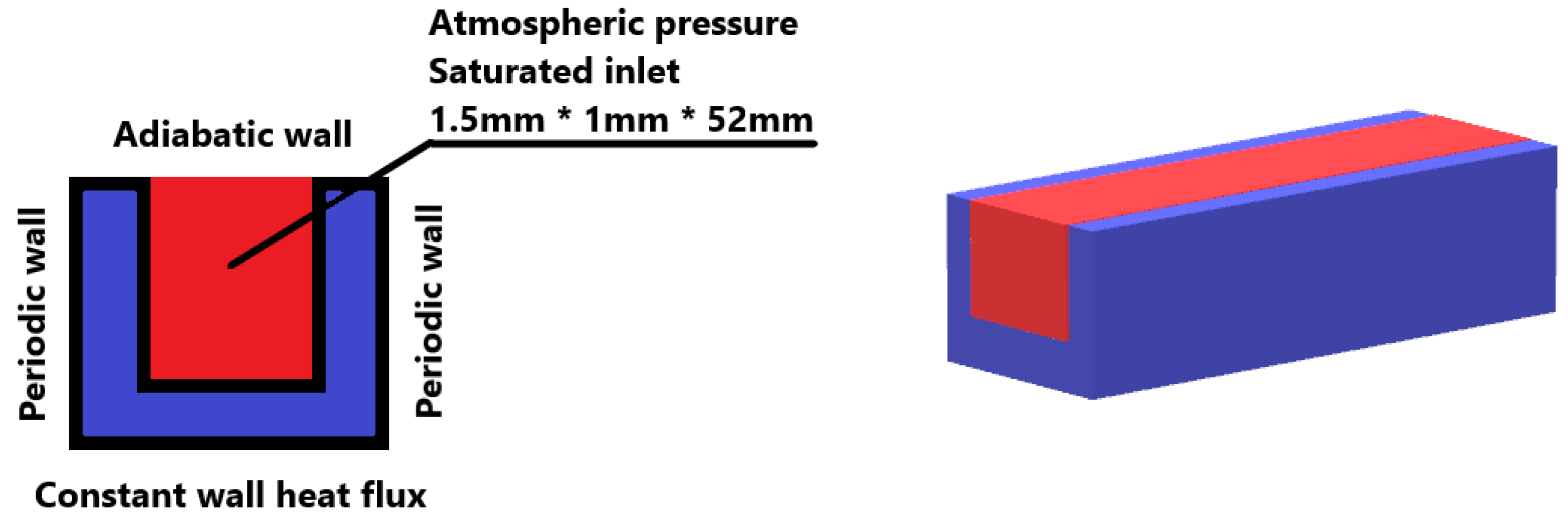
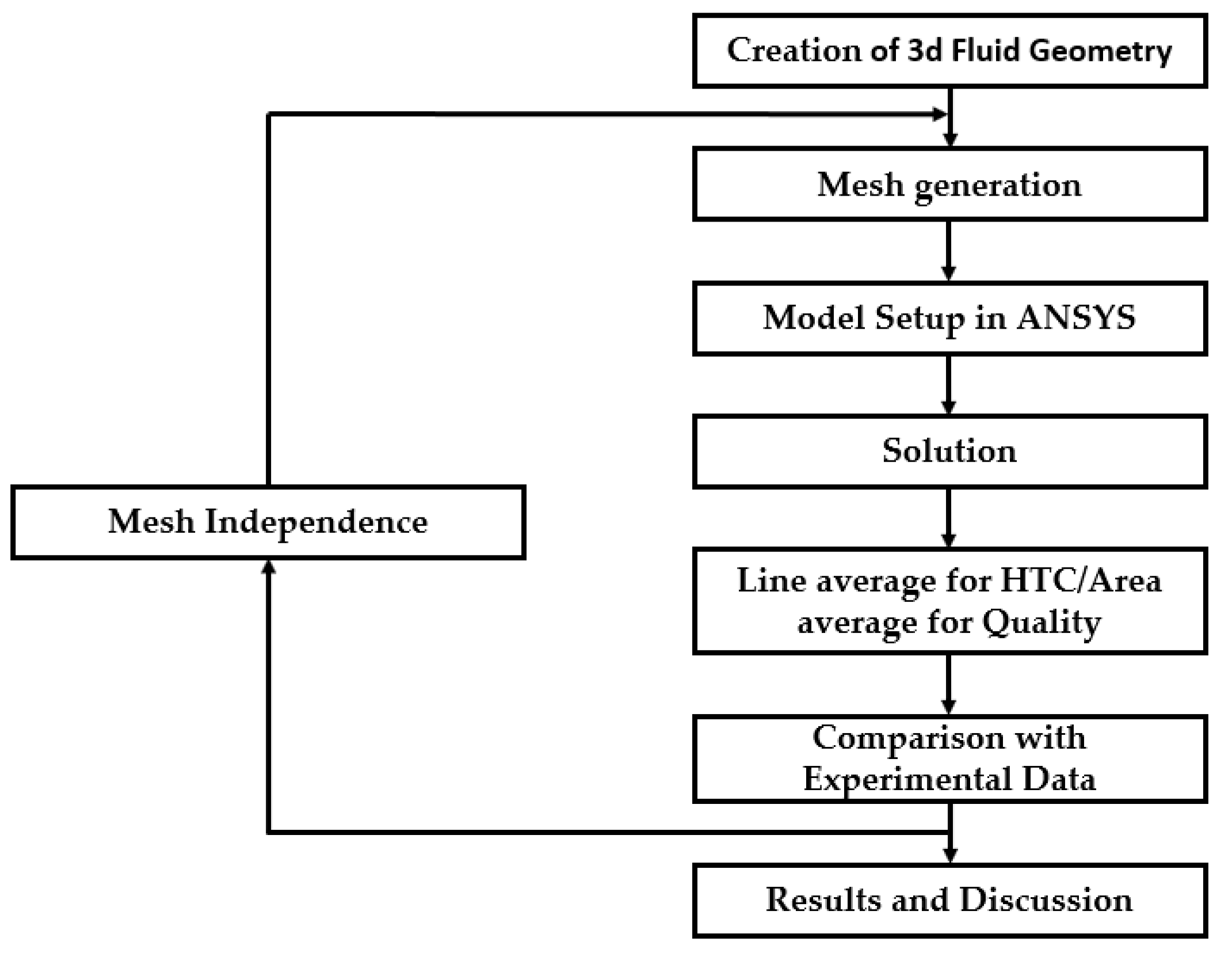

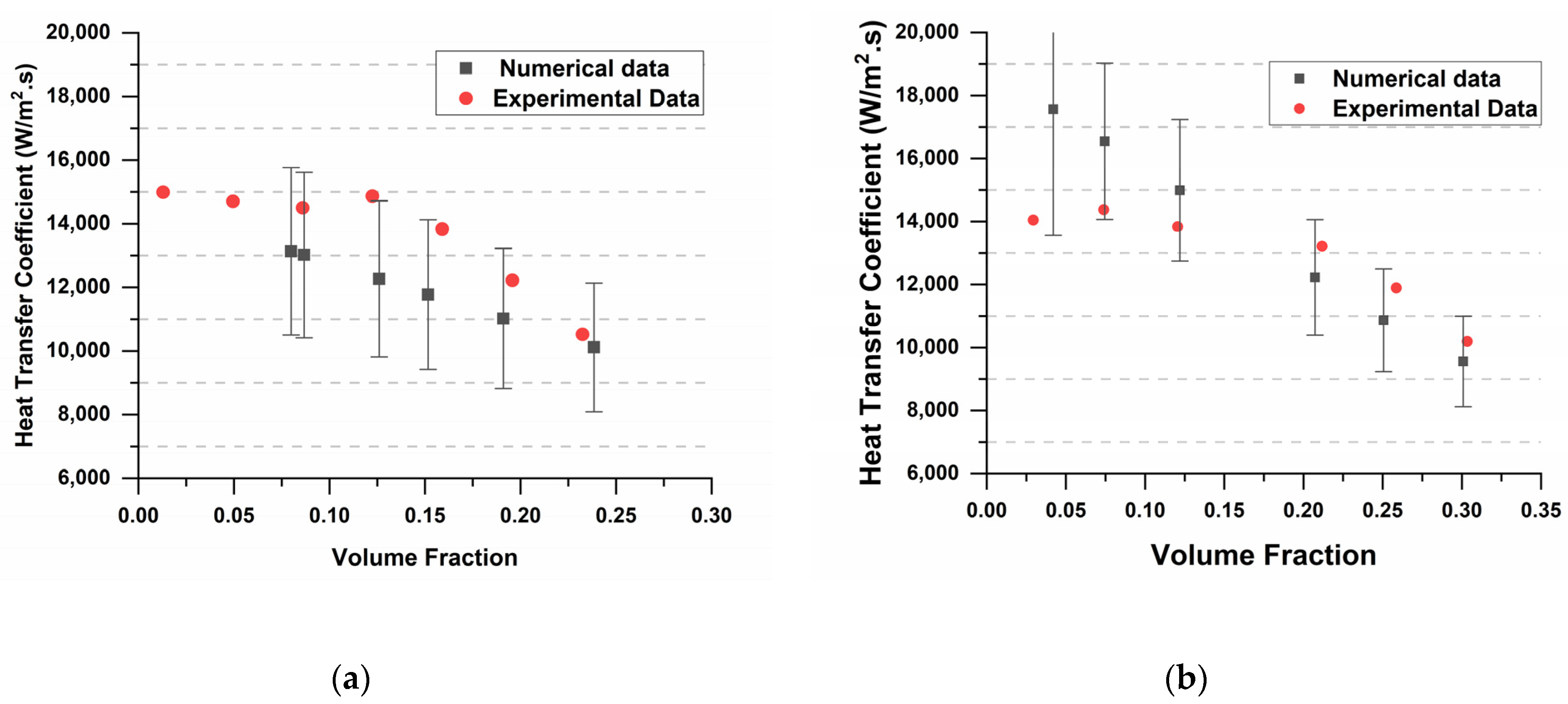
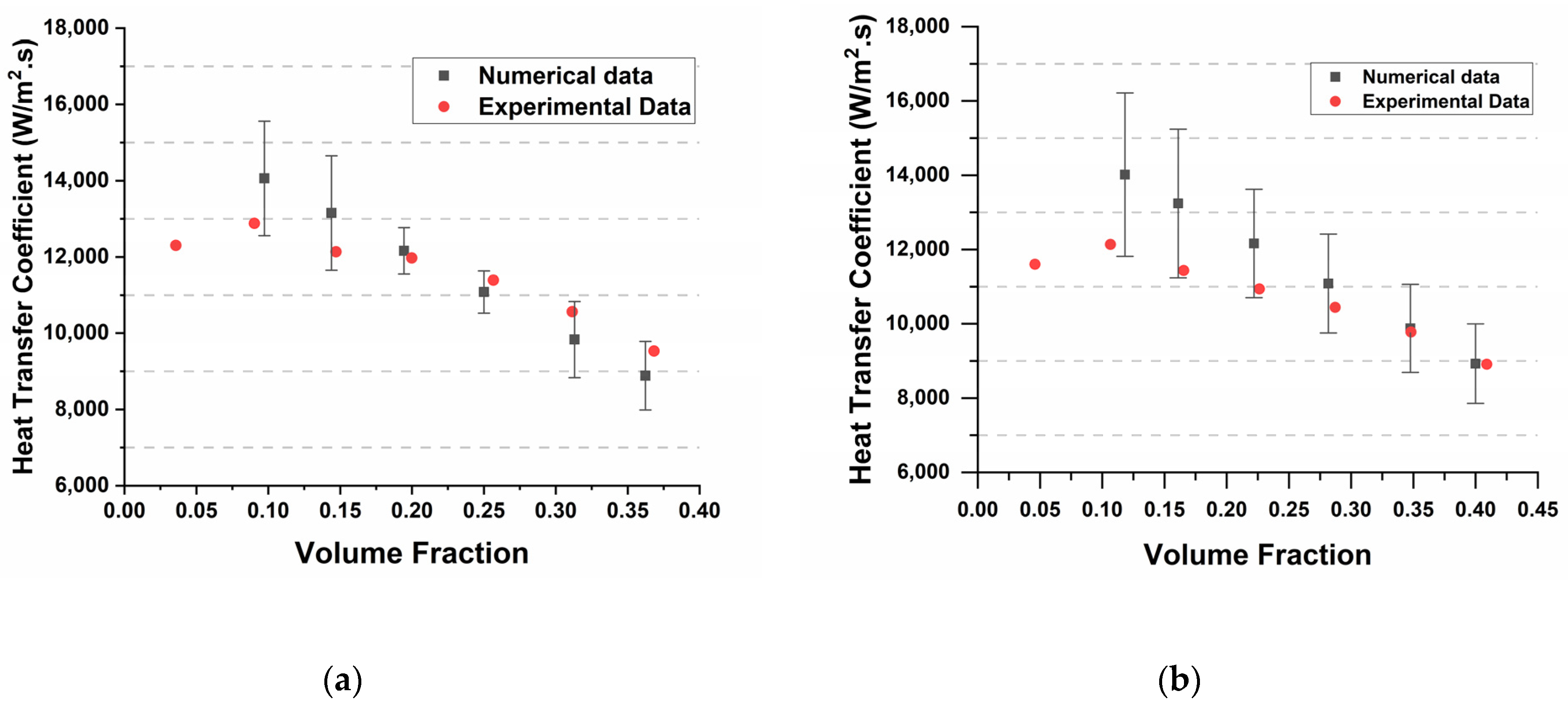
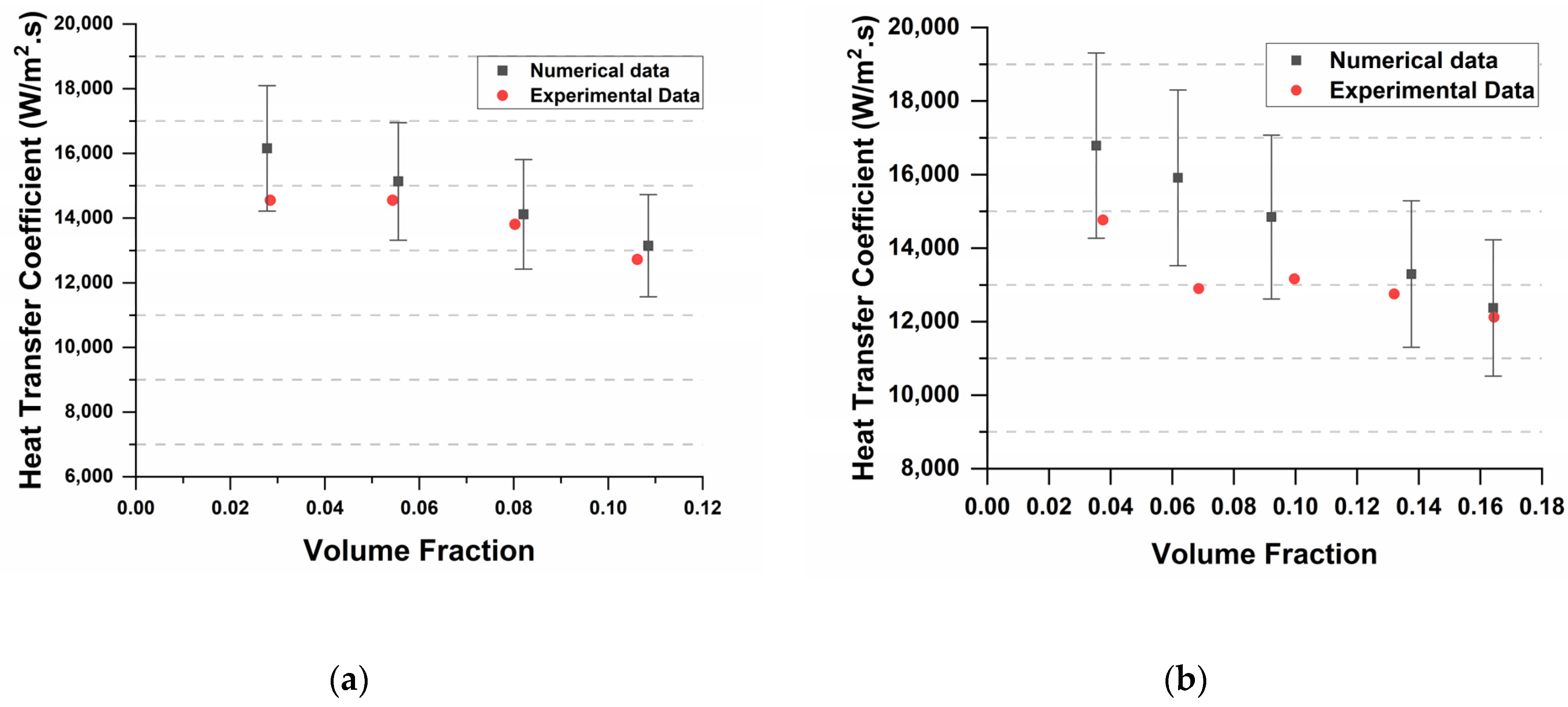
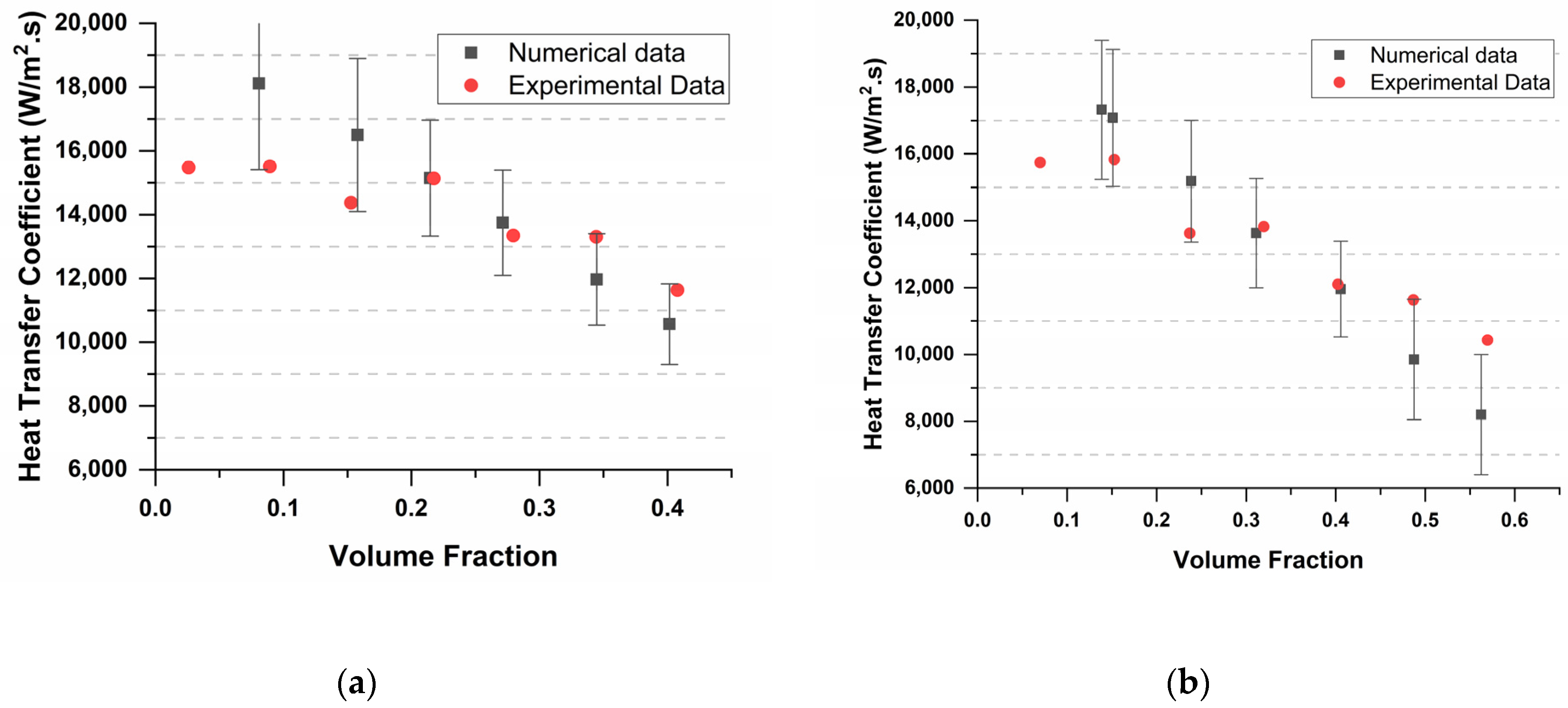
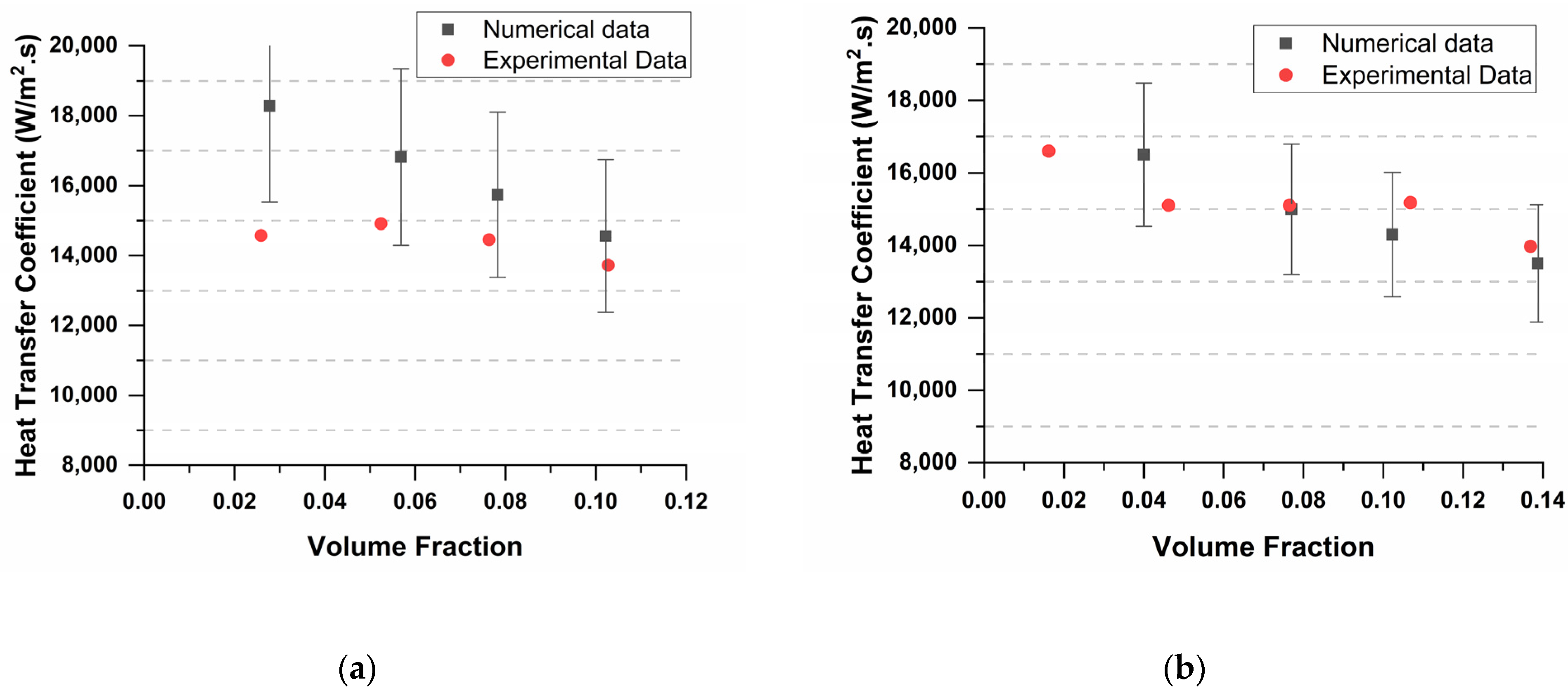
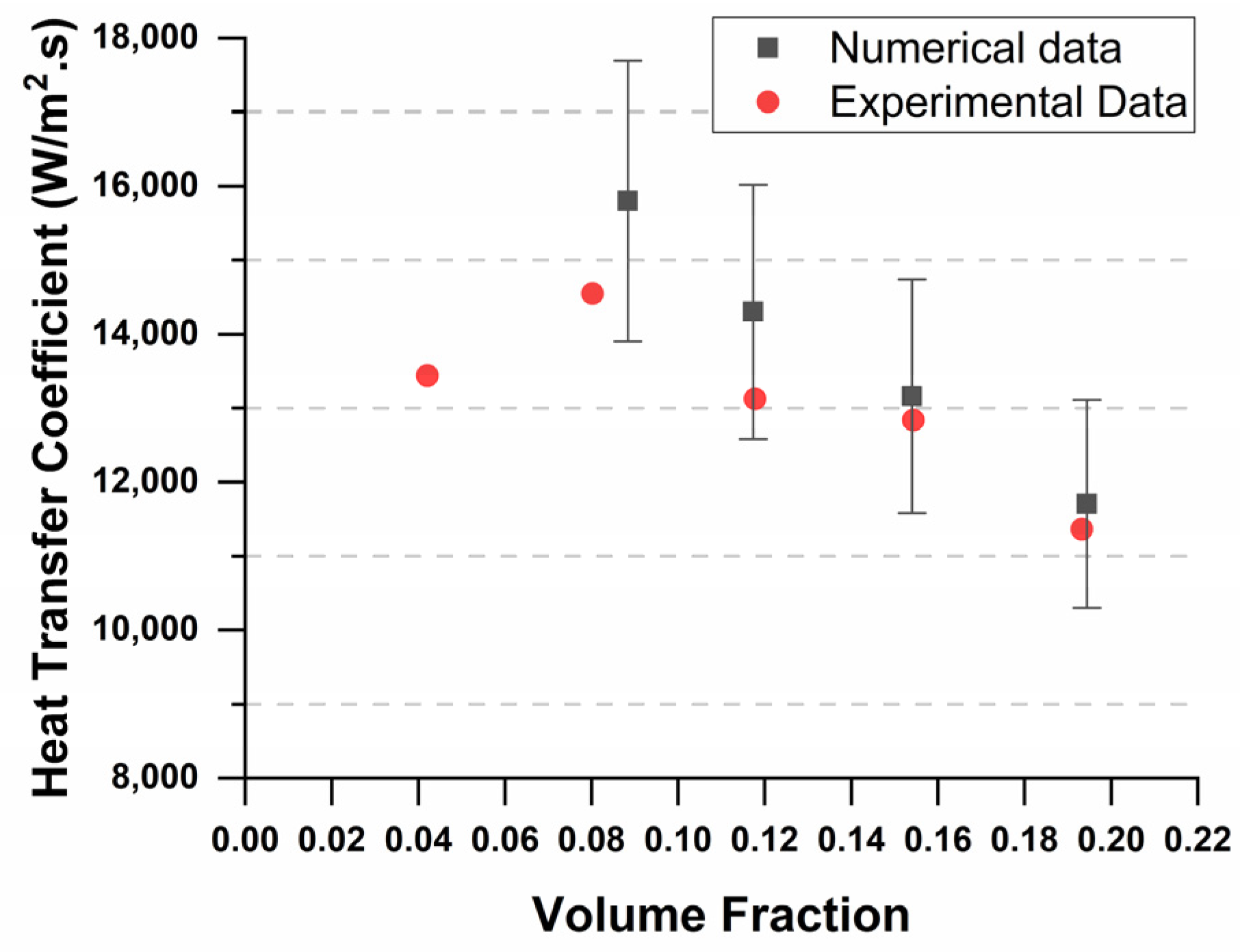
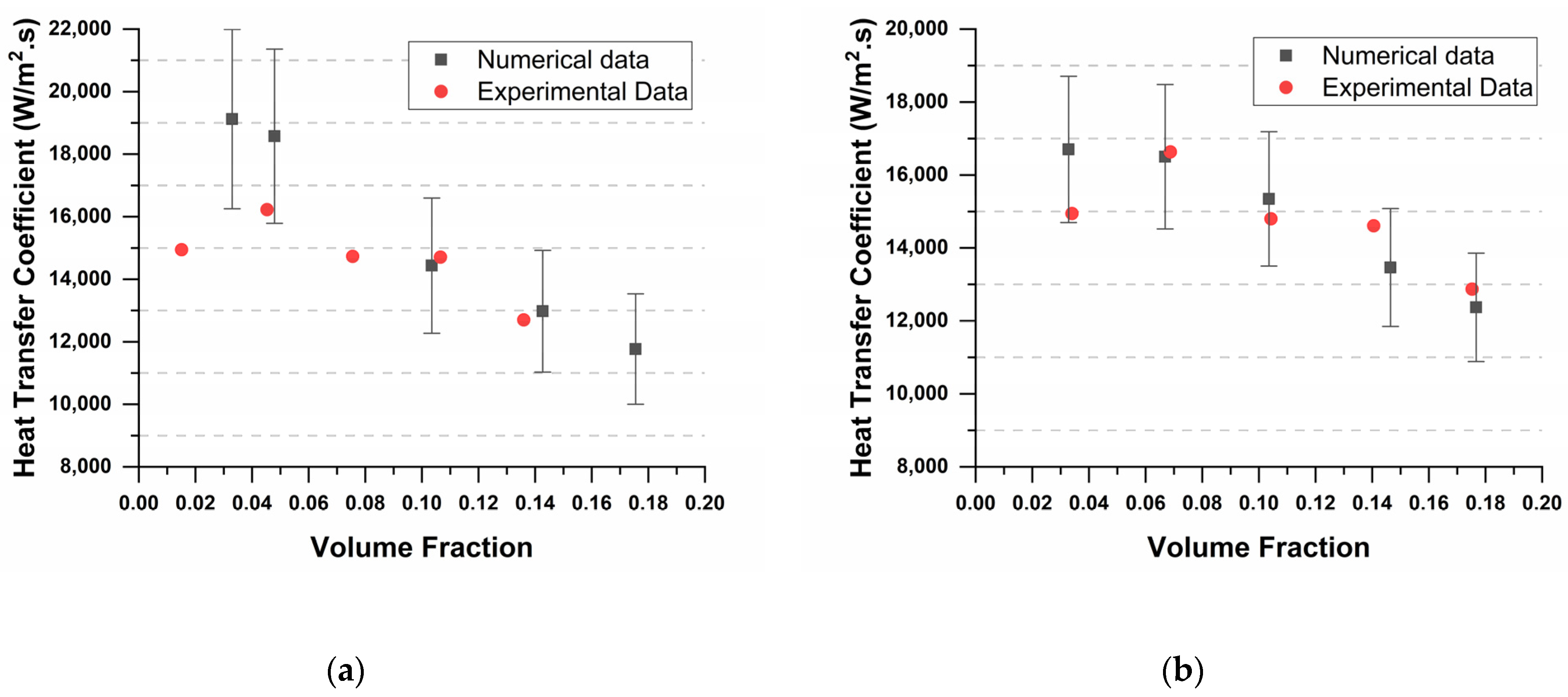

Disclaimer/Publisher’s Note: The statements, opinions and data contained in all publications are solely those of the individual author(s) and contributor(s) and not of MDPI and/or the editor(s). MDPI and/or the editor(s) disclaim responsibility for any injury to people or property resulting from any ideas, methods, instructions or products referred to in the content. |
© 2024 by the authors. Licensee MDPI, Basel, Switzerland. This article is an open access article distributed under the terms and conditions of the Creative Commons Attribution (CC BY) license (https://creativecommons.org/licenses/by/4.0/).
Share and Cite
Khan Mughal, M.U.; Waheed, K.; Sadiq, M.I.; Molla, A.H.; Harun, Z.; Etminan, A. Water Flow Boiling in Micro/Mini Channels Using Volume of Fluid Model. Appl. Sci. 2024, 14, 759. https://doi.org/10.3390/app14020759
Khan Mughal MU, Waheed K, Sadiq MI, Molla AH, Harun Z, Etminan A. Water Flow Boiling in Micro/Mini Channels Using Volume of Fluid Model. Applied Sciences. 2024; 14(2):759. https://doi.org/10.3390/app14020759
Chicago/Turabian StyleKhan Mughal, Muhammad Umer, Khalid Waheed, Muhammad Imran Sadiq, Altaf Hossain Molla, Zambri Harun, and Amin Etminan. 2024. "Water Flow Boiling in Micro/Mini Channels Using Volume of Fluid Model" Applied Sciences 14, no. 2: 759. https://doi.org/10.3390/app14020759





